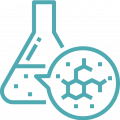Electroless Nickel Plating is a treatment that gives metal high resistance to abrasion, attack by corrosive substances and wear over time.
EMMEBI S.r.l. applies to the base-metal its coating process “NITEK” (Electroless Nickel Plating). This is a chemical nickel plating process using a proprietary formulation of the working solution based on the red-ox effect, in absence of electric current. Nickel deposition is solely due to the chemical interaction between solution and metal and gives the metal coating a high degree of uniformity, regardless of the complexity of the surface, unlike other galvanic platings.
NITEK coating thickness, is precise and uniform and can be defined according to the customer’s mechanical and technical requirements. Standard coating thicknesses depend on the end use and vary between 5-10 microns for non-heavy duty, 25-50 microns for medium-heavy duty, and 70-100 microns for very heavy duty.
Technical characteristics
The merits of NITEK coating are many, starting with its chemical resistance, uniformity, and versatility. Let's examine them in detail.
Applications
Chemical nickel plating applies to all areas where metallic materials need to be coated to make them more durable, whether large pieces or high-precision micro-components.
We are distinguished by the craftsmanship of our processes, which translates into quality excellence. All the processes are carried out in accordance with precise standards, monitored and certified regularly.




